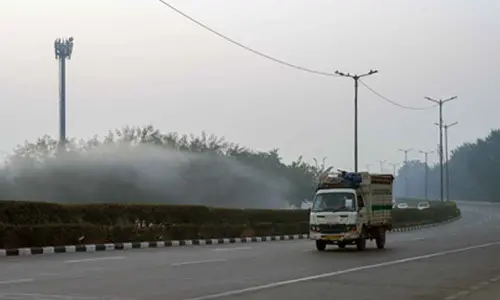MGNREGS: Plug loopholes, don’t dilute

Statements made by the Union Ministers and other officials concerned regarding the Mahatma Gandhi National Rural Employment Generation Scheme (MGNREGS) in the recent past have aroused doubts about the future of the Scheme among different sections of people.
Statements made by the Union Ministers and other officials concerned regarding the Mahatma Gandhi National Rural Employment Generation Scheme (MGNREGS) in the recent past have aroused doubts about the future of the Scheme among different sections of people. A group of economists has written to Prime Minister Narendra Modi, expressing their deep concern about the future of MGNREGS. The PM in the recent Budget Session stated that he would not commit the political mistake of discontinuing the Scheme but would continue it to highlight the failure of the past Government. This raises doubt whether new government will implement the Scheme in both letter and spirit.
The results of evaluation studies on MGNREGS carried out at regional and national levels are mixed and a bit confusing. Most of studies have observed that the Scheme is self-targeting as a larger proportion of SC/ST households, women workers and poor landless labourers are actively participating in the Scheme. Another beneficial outcome of the Scheme is the increasing wage rate for the works on private lands. Due to direct and indirect benefits, the participating households experienced a gain in income. Consequently, there is decline in poverty, distress migration, indebtedness and improvement in credit-worthiness of the vulnerable sections of the society. Some studies have found that additional income derived from the Scheme is being spent on consumption of food, education of the children and health of the family members.
At the same time some studies highlighted the negative elements in the scheme like poor coverage, low volume of employment generated, delay in wage payments etc. Some studies have dealt with escalation in the cost of cultivation due to the hike in market wage rate, decline in cultivated area and threat to the food security of the Poor.
In this context should we continue MGNREGS? Does it need restructuring to make it more effective? How do benefits differ across different types of villages, households belonging to different land categories and social classes? The present paper seeks to answer these questions with the help of field data collected in selected villages of Telangana State.
Based on a couple of performance indicators, three districts namely, Ranga Reddy district (a relatively better performing district), Nizamabad district (moderately performing district) and Warangal district (a lagging district) were selected. For field study, Kothlapur and Gottiga Khurd from Ranga Reddy district, Rudraram and Tujalpur from Nizamabad district, and Kodvatoor and Janakipur from Warangal district were selected. As many as 35 households participating in the scheme with due weight-age to different categories of beneficiaries were selected from each village. In all, 210 households were included in the sample.
A wage-seeker participating in the Scheme benefits in terms of direct employment under the Scheme, higher market wage rate and consequent gain in income. Before the implementation of MGNREGS, a wage-seeker worked for 195 days which consisted of 35 days of work in his own field and 160 days as wage labourer.
After the implementation of the Scheme, the wage-seeker, on an average, worked for 212 days which consisted of 33 days of work under the Scheme, 35 days in his own field and 144 days on private land as wage labourer. Thus due to the Scheme, the employment to a wage-seeker increased from 195 days to 212 days i.e., by 9%.
However, in the case of landless labourers, days of employment provided under MGNREGS could not fully compensate the reduction in wage employment on private lands.
Before MGNREGS, a wage-seeker used to work for 150 days per annum on private lands. But with the implementation of MGNREGS, this figure dropped to a low level of 113 days i.e., a loss of 37 days. But the wage-seeker could get only 34 days of employment under MGNREGS. Therefore, the ceiling on days of employment per household under NREGS must be higher for landless and marginal farmers.
The market wage rate for a wage-seeker increased by 150% from Rs 62 to Rs 154. Consequently, income of an earner increased by Rs 9,000 i.e., from Rs 22,000 to 31,000 in 2012-13 prices. In percentage term, it works out to a gain of 40%.
The government under the Scheme has provided 33 days of employment to a wage-seeker at a wage rate of Rs 113 per day. Thus, the wage bill per worker was Rs 2,729. In 2012-13, the wage component happened to be 74 per cent of total expenditure. Therefore, the total expenditure per wage-seeker works out to be Rs 5,039.
In short, the benefit derived by a wage-seeker from the Scheme, on the whole, was about Rs 9,000 while expenditure incurred by the government was about Rs 5,000. Hence the benefit-cost ratio works out to be 1.8. In other words, for every one rupee spent by the government, a wage-seeker derives a benefit of about Rs 2.
The village-wise analysis reveals that MGNREGS is likely to generate more benefits to the wage-seekers in villages having low wage rate like Janakipur compared to villages having high wage rate like Kodavatoor. Hence, it would be worthwhile to implement the Scheme more intensively in villages where the existing market wage rate is low.
Analysis of households by size of the land holding reveals that the benefit derived by the large farmers participating in the Scheme is more than the benefit derived by landless labourers. The large farmers are benefiting in two ways, namely, by actively participating in MGNREGS programme and by substituting hired labour by family labour and machines.
The results indicate that SC households benefit to the extent of Rs 2 for every rupee spent by the government. The corresponding figures for BC households and households belonging to other castes are Rs 1.8 and Rs 1.2, respectively. It is observed that SC households are deriving larger benefits as they participate for larger number of days in the Scheme.
To conclude the benefits derived from the Scheme are substantial compared to the expenditure incurred on the Scheme. However, there is vast scope for improvement. Village-wise analysis suggests that it would be worthwhile to implement the Scheme intensively in villages where the existing wage rate for private works is low. The analysis by the land category suggests that the ceiling on days of employment per household under MGNREGS must be higher for landless and marginal farmers.
To plug the leakages e-muster roll along with manual muster roll must be introduced in all the districts. Further, the wage payment should be through post office, bank or CSP. To avoid escalation of cost of cultivation, some operations concerning cultivation on private lands must be included under MGNREGS.
By: S Indrakant




















